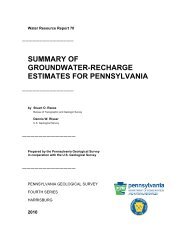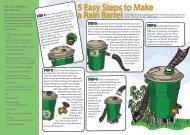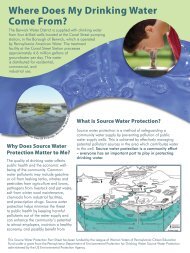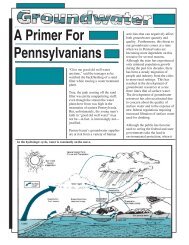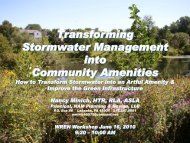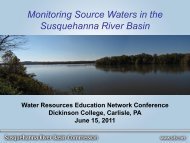NITROGEN POLLUTION: - Hubbard Brook Research Foundation
NITROGEN POLLUTION: - Hubbard Brook Research Foundation
NITROGEN POLLUTION: - Hubbard Brook Research Foundation
Create successful ePaper yourself
Turn your PDF publications into a flip-book with our unique Google optimized e-Paper software.
WATERSN is a nitrogen model for coastal watersheds that estimates total nitrogen<br />
loading to specific estuaries based on a numerical accounting of all watershed inputs<br />
(food, feed, fertilizer, deposition and nitrogen fixation in cropland) and all watershed<br />
nitrogen losses (Castro et al. 2000). Individual sources of reactive nitrogen can be<br />
altered to predict the change in estuarine nitrogen loading that would result from<br />
nitrogen pollution controls.<br />
We defined several nitrogen reduction scenarios based on current policy options<br />
that would decrease nitrogen inputs to the estuaries. The scenarios target nitrogen<br />
reductions from each of the major sources that contribute reactive nitrogen to estuaries<br />
in the Northeast.<br />
Estuary Nitrogen Reduction Scenarios<br />
l<br />
l<br />
l<br />
l<br />
Wastewater nitrogen scenarios<br />
~ Implementation of biological nitrogen removal (BNR) at wastewater treatment plants<br />
throughout the entire watershed.<br />
~ Implementation of BNR at wastewater treatment plants within the coastal zone.<br />
~ Combined basinwide BNR and improvement in septic system treatment.<br />
~ Displacement of nitrogen to the continental shelf through offshore pumping.<br />
Agricultural scenarios<br />
~ 34% reduction in nitrogen emissions from agricultural facilities through the treatment of<br />
animal waste.<br />
~ 33% reduction in edge-of-field nitrogen runoff from agricultural facilities through increased<br />
use of best management practices.<br />
Airborne nitrogen scenarios<br />
~ 75% reduction in NO x<br />
emissions from electric utilities from current emissions levels by 2010.<br />
~ Reductions in vehicle emissions of NO x<br />
consistent with the U.S. EPA Tier 2 regulations.<br />
~ 90% reduction in vehicle emissions of NO x<br />
beyond the levels achieved through Tier 2.<br />
Integrated<br />
~ Basinwide BNR, 90% reduction in NO x<br />
emissions from vehicles beyond the Tier 2 standard,<br />
75% reduction in NO x<br />
emissions from electric utilities and 33% decrease in edge-of-field<br />
runoff from agricultural facilities.<br />
The WATERSN model results (see Figure 19) are useful in guiding nitrogen<br />
management for coastal systems. The model analysis demonstrates that:<br />
1. Differences in land use and population size have a substantial impact on the<br />
relative effectiveness of the reduction scenarios for Long Island Sound and Casco<br />
Bay. For example, in the more highly populated watershed that drains to Long<br />
Island Sound, improvements in wastewater treatment plants reduce reactive<br />
nitrogen loading to a greater extent than in the less populated Casco Bay<br />
watershed.<br />
2. Improved wastewater treatment results in the largest reduction in reactive<br />
nitrogen loading to Long Island Sound and Casco Bay. Basinwide BNR and<br />
improvements in septic systems would achieve approximately a 55 percent<br />
reduction in reactive nitrogen loading to Long Island Sound and 40 percent to<br />
Casco Bay.<br />
PAGE 22



